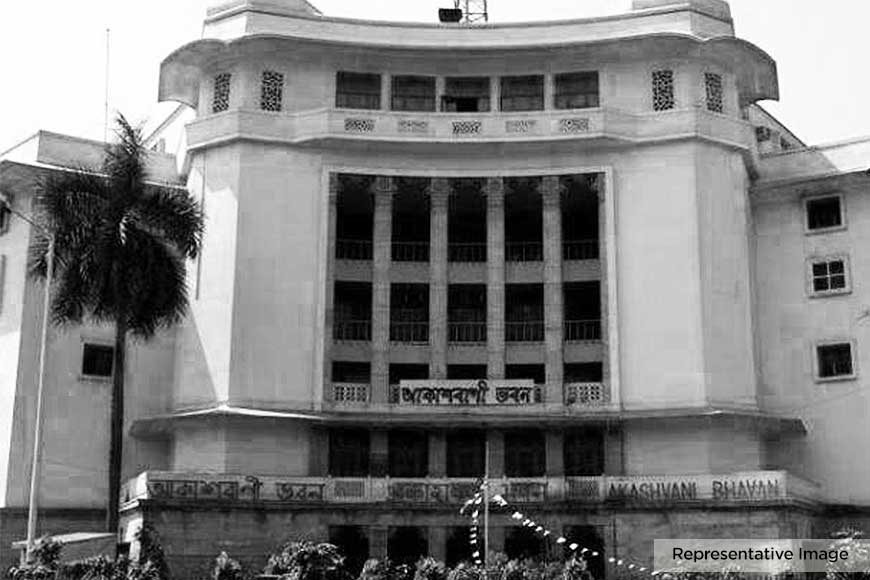India’s first Broadcasting Company was here in Kolkata where Ghosts of Garstin Place rule

It was an ancient building, amid a narrow lane on Council House Street, opposite St John’s Church. It was the All India Radio (AIR) office at 1, Garstin Place in Central Kolkata. This building was constructed by East India Company and served as a hospital between 1700 and 1763. This was the first hospital set up by the East India Company and Alexander Hamilton wrote that patients went to the hospital in hordes for treatment but their state after the procedure was shrouded in mystery. The lane was a busy thoroughfare frequented by pedestrians. During those times, all the neighbouring buildings were also known as Garstin Buildings.
Major General John Garstin (1756 – 1820) of Bengal Engineers, was a very close friend of Warren Hastings. In 1784, the nascent British administration in India assigned Captain John Garstin to design and construct the very first government granary in Patna’s Bankepur area. He implemented a unique structure that still stands erect on Fraser Road and is known as ‘Golaghar.’ One of Kolkata’s most impressive structures, the Town Hall, built in Roman Doric style in 1813 was planned and executed by Garstin. He was promoted to the post of Surveyor General of Bengal and served as the sixth Surveyor General from 1808 to 1813.
In 1792, he supervised the demolition of the Old Court House. He re-used the materials obtained from the demolishing for constructing buildings in the northern part of St John’s Church. Those houses were named after him as Garstin House. He died on February 16, 1820 and was buried at the South Park Street Cemetary. Much later, the lane was taken over by Calcutta Corporation and the area was named Garstin Place.
At one time, the building on Garstin Place was the main office of Indian Broadcasting Company (IBC). Set up on the lines of the BBC, the privately owned Indian Broadcasting Company started India’s first broadcasting studio and office in Apollo Bunder Road, Bombay. Soon they opened their Calcutta station at Temple Chamber, opposite High Court, but then moved to No 1, Garstin Place and started to broadcast from August 26, 1927. In 1936, the company was taken over by the government and re-named All India Radio. The Calcutta station’s first director was CC Wallick of the BBC, while Nripendra Nath Majumdar was in charge of producing all the Indian programmes. The building, No 1, Garstin Place is famous because it was All India Radio, Kolkata’s first office. In 1961, the office was shifted to its present location close to the Eden Gardens and AIR started functioning from the new swanky Akashvani Bhavan.
Also read : Ghosts at Kolkata’s Presidency Jail!
The AIR office at No.1 Garstin Place was initially located on the second and third floors of the building, while the first floor was occupied by a wine merchant, a ‘gora sahib.’ After a few years, the wine shop downed its shutter and the AIR took over the entire building. The stairs of the old Victorian-style building that led to the floors upstairs were wooden and to avoid any loud sound of footsteps being carried into the studio, the officials directed that the stairs be covered in a thick carpet.
Musical and dialogue programmes, termed as European and Indian, were broadcasted every evening for 3-4 hours. The signature tune of AIR was composed by John Foulds and created by the combination of violin, viola, cello and tanpura. The duration of the tune was eight seconds which used to be repeated after intervals of 10 seconds in between.
Renowned musician Rai Chand Boral was one of Majumdar’s assistants. Birendra Krishna Bhadra was also associated with AIR for several decades, as the producer of the drama section. He also presented ‘Birupaksher Aasar’ broadcasted every Sunday at 1.00 pm, which was a very popular programme with the audience and created quite a stir at the time. But the crowning glory of his career in All India Radio, Calcutta was his performance in ‘Mahishasura Mardini’, where he chanted the Slokas of Sri Sri Chandi. The programme was first introduced in 1937.
This office was visited by many renowned personalities. It is said that the unimpressive, small building at 1, Garstin Place, which gradually turned into the cultural hub of the city, was a haunted place. Finally, the Calcutta station of AIR shifted to its new premises and a legend was deserted, left to perish in isolation. The ancient building that had immense historical importance and was the harbinger of a cultural revolution of sorts was demolished unceremoniously in January 1997.









